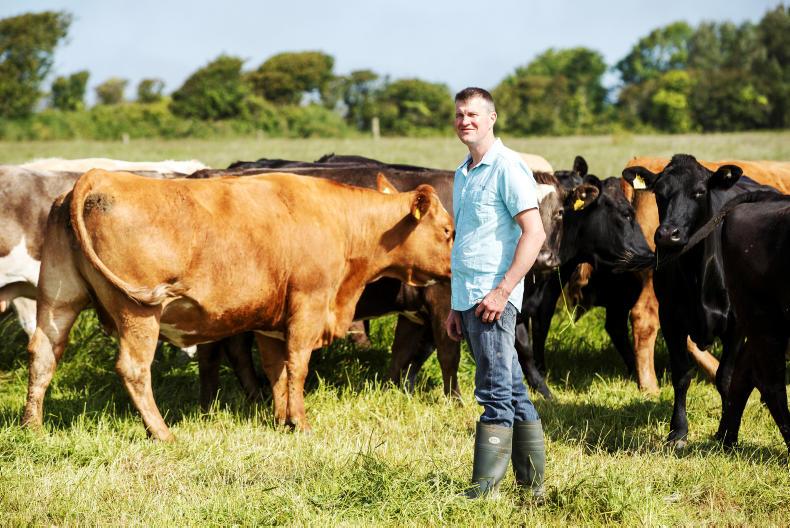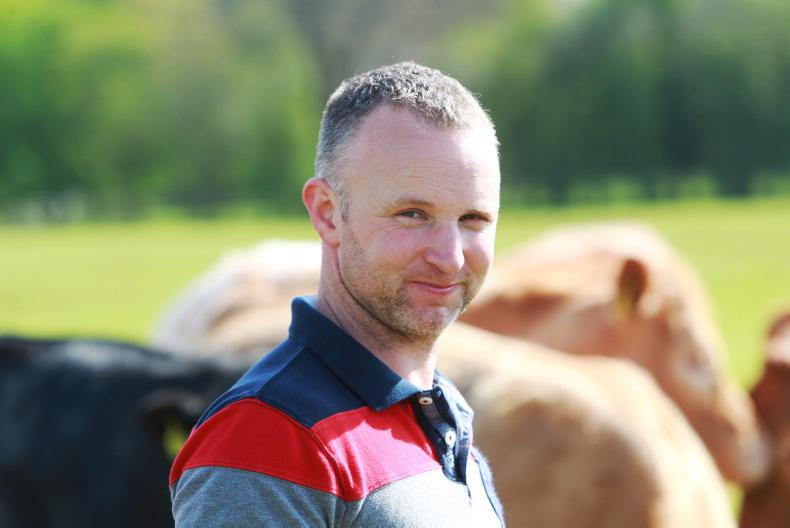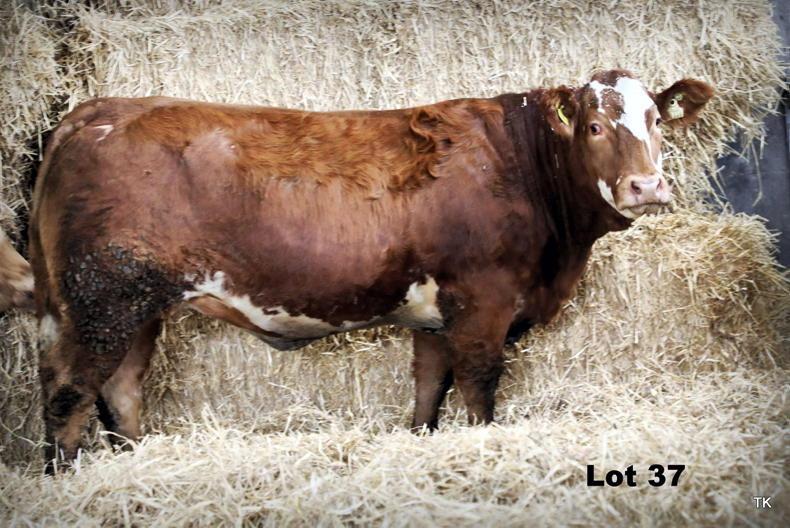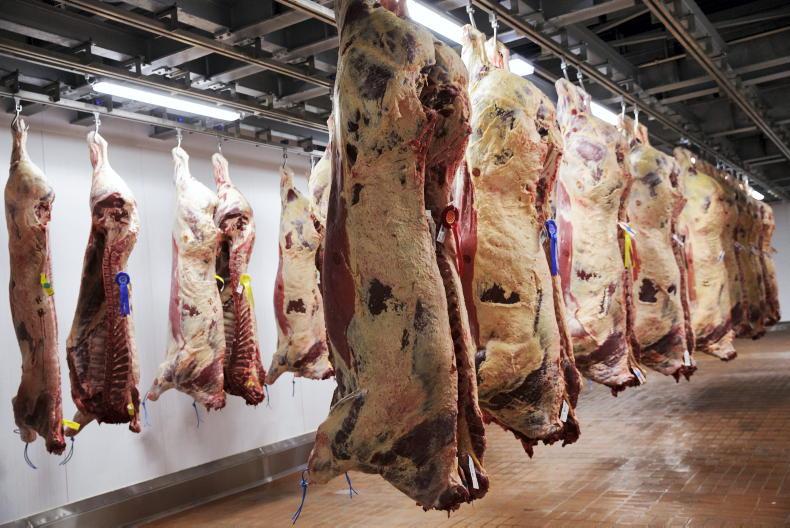In this week’s paper, we look at the bull and steer carcase performance on our finishing farms to date. As a prelude, the heifer carcases are under for scrutiny here. Bought-in animals are not included in the analysis. The table below lists the top five performers and the average when it comes to heifer carcases.
How does your own performance relate?
Between 1 January 2017 and the end of February this year, 14 of our 27 BETTER farms sent beef bulls for slaughter while 13 killed steers. There is no doubt that these numbers will grow as the programme moves on and the participants grow in confidence from a feeding point of view. Many have excelled at finishing in their first year. As we document in the BETTER farm article in this week’s paper, a first-time finisher tops one of our system-based tables.
Finishing heifers
Heifer finishing is a somewhat simpler process and, given the animal’s predisposition to lay down more fat than a male, can be done with lower feed inputs and less fear of missing fat scores. Nineteen of the BETTER farm group slaughtered beef heifers in early-2018.
Weight for age is an important metric for finishing farms. Generally in Ireland, shed space is our first limiting factor when it comes to carrying numbers. Getting animals out the gate sooner takes pressure off sheds. Also, a younger animal is more feed efficient and so we are getting more bang for our buck when putting feed into their troughs. Going forward, weight for age could well be pushed hard as a means to reduce carbon emissions. As we showed last week, a younger age at slaughter was one aspect of a systems trial that reduced carbon emissions by almost 20%.
Put plainly, heifer slaughter performance could be better across the group. Producing a 318kg carcase on a heifer is satisfactory, but for me, 23 months is a little too long to be looking at a beef heifer for such a weight. Granted the cocktail of female sex hormones and a small-to-medium type cow model is hitting some farmers hard. But, if we get nutrition in our heifers right and have good genetics we can hit big carcase weights at 18-20 months. Waterford’s Maurice Hearne tops the table, with weights that would satisfy a bull finisher at 20 months.
A forward heifer will stall in the second half of the grazing season as the kick goes from grass and the weather turns. If we are to get weights and fat scores up prior to the winter period, we either need to house and feed hard or offer meals at grass. I would tend towards the latter, with plainer type animals, while looking to house and feed on potential R+ or U-grade animals. These will make money for us every day indoors if managed right.
Housing and labour
With stock numbers still building in year one, there wasn’t a huge pile of housing pressure to get these heifers away early and farmers were largely happy to leave the animals outdoors on grass until the need for housing arose.
Remember too, the labour input required to supplement these daily. As genetics improve and numbers grow, I expect this weight figure to go up and the corresponding slaughter age figure to reduce.
Read more
All reports from the BETTER farm programme
In this week’s paper, we look at the bull and steer carcase performance on our finishing farms to date. As a prelude, the heifer carcases are under for scrutiny here. Bought-in animals are not included in the analysis. The table below lists the top five performers and the average when it comes to heifer carcases.
How does your own performance relate?
Between 1 January 2017 and the end of February this year, 14 of our 27 BETTER farms sent beef bulls for slaughter while 13 killed steers. There is no doubt that these numbers will grow as the programme moves on and the participants grow in confidence from a feeding point of view. Many have excelled at finishing in their first year. As we document in the BETTER farm article in this week’s paper, a first-time finisher tops one of our system-based tables.
Finishing heifers
Heifer finishing is a somewhat simpler process and, given the animal’s predisposition to lay down more fat than a male, can be done with lower feed inputs and less fear of missing fat scores. Nineteen of the BETTER farm group slaughtered beef heifers in early-2018.
Weight for age is an important metric for finishing farms. Generally in Ireland, shed space is our first limiting factor when it comes to carrying numbers. Getting animals out the gate sooner takes pressure off sheds. Also, a younger animal is more feed efficient and so we are getting more bang for our buck when putting feed into their troughs. Going forward, weight for age could well be pushed hard as a means to reduce carbon emissions. As we showed last week, a younger age at slaughter was one aspect of a systems trial that reduced carbon emissions by almost 20%.
Put plainly, heifer slaughter performance could be better across the group. Producing a 318kg carcase on a heifer is satisfactory, but for me, 23 months is a little too long to be looking at a beef heifer for such a weight. Granted the cocktail of female sex hormones and a small-to-medium type cow model is hitting some farmers hard. But, if we get nutrition in our heifers right and have good genetics we can hit big carcase weights at 18-20 months. Waterford’s Maurice Hearne tops the table, with weights that would satisfy a bull finisher at 20 months.
A forward heifer will stall in the second half of the grazing season as the kick goes from grass and the weather turns. If we are to get weights and fat scores up prior to the winter period, we either need to house and feed hard or offer meals at grass. I would tend towards the latter, with plainer type animals, while looking to house and feed on potential R+ or U-grade animals. These will make money for us every day indoors if managed right.
Housing and labour
With stock numbers still building in year one, there wasn’t a huge pile of housing pressure to get these heifers away early and farmers were largely happy to leave the animals outdoors on grass until the need for housing arose.
Remember too, the labour input required to supplement these daily. As genetics improve and numbers grow, I expect this weight figure to go up and the corresponding slaughter age figure to reduce.
Read more
All reports from the BETTER farm programme










SHARING OPTIONS